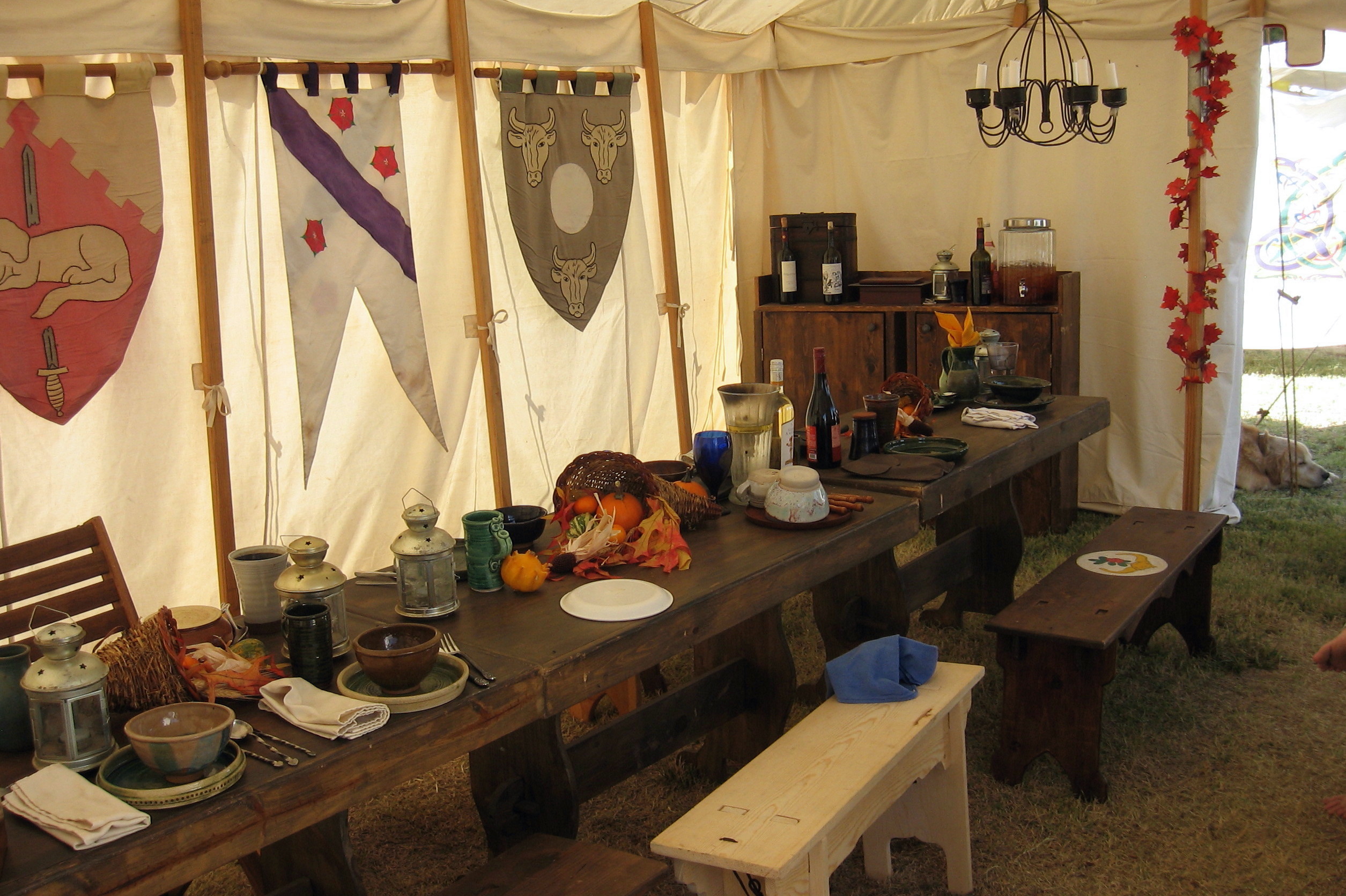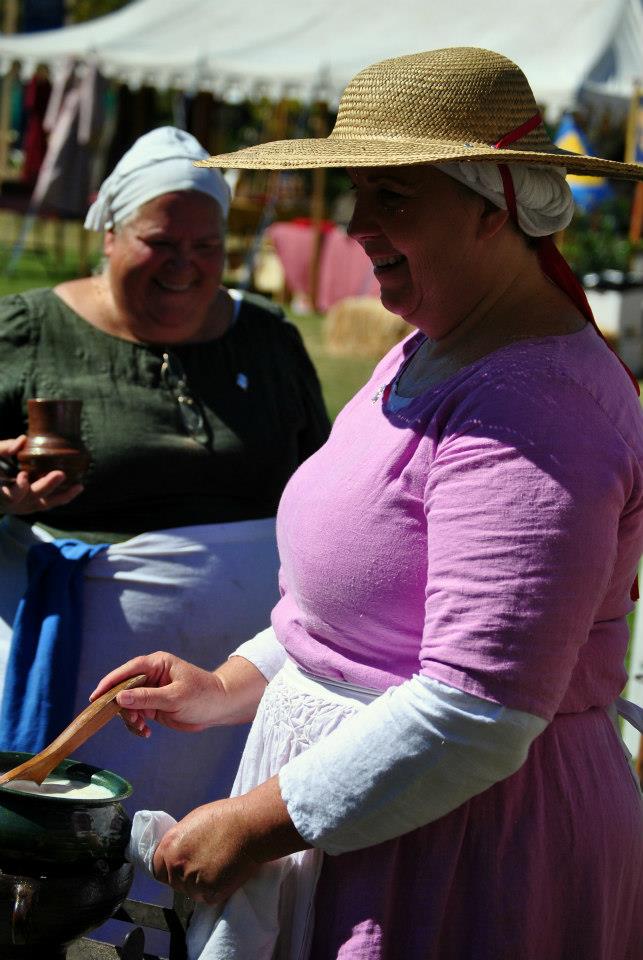My SCA household has two major parties every year, a yearly birthday celebration in the summer and a Yule celebration sometime during the holiday season. Each party has some sort of mundane theme (probably because we think we are hilarious). We’ve had Pirates on the Loch, Summer of Love, The Chicago Caper Murder Mystery, Cows in Paradise…. you get the idea! But, one year, we decided to truly celebrate what we love most — our SCA lives — and Cliar Cu Buidhe Twelfth Night, 2010, was the result.
Let’s have a period party!
This was planned to be the Twelfth Night celebration of our dreams! We would begin with a period feast, but one that would hopefully make us feel like we had stepped into the pages of Chaucer’s Canterbury Tales. We planned a typical Cliar Cu Buidhe style menu, meaning foods of the SCA period were to be on the menu, but not necessarily redacted period dishes. We would have a simple feast, food totally prepared ahead of time and served to us at one elegant table, large enough for us all.
<><><>
The festivities began around 5:00 p.m. on a Saturday afternoon. As guests arrived, they were offered libation and a seat at the fire, until time when the Great Hall would be opened to all and the feast would begin. We had hired two servants for the evening, a man and his young sister, who worked for stipend and an opportunity to dine in the hall with us, below the salt, of course. Upon their arrival, they received their instruction from the cook and directions to the scullery, then set to complete last minute details in the Great Hall.

The bell was rung, and a hymn offered to Saint Columba:
Salve splendor et patrone
iubarque iusticie
orthodoxe doctor bone
pastor et vas gratie
O Columba Columbine
felicis memorie
tue facnos sine fine
coheredes glorie.
Hail, glorious protector,
light of justice,
true and virtuous teacher,
shepherd and vessel of grace.
O dove-like Columba,
grant us happy remembrance
of you forever,
co-heir of glory.
<><><>
 The door to the Great Hall was opened and guests were led in. They were escorted, first, to a side table, where the servants assisted with the ceremonial handwashing, using an aquamanile that had been made for the house by a local potter, Master Hroar Stormgangr.
The door to the Great Hall was opened and guests were led in. They were escorted, first, to a side table, where the servants assisted with the ceremonial handwashing, using an aquamanile that had been made for the house by a local potter, Master Hroar Stormgangr.
<><><>
The hall was illuminated with flickering candles and the walls were draped with the colorful personal banners of the guests. Benches lined the long, linen-covered table, which was set with greenery, nuts and seasonal fruits, and ceramic jars filled with ale, mead and home-brewed pear and plum wines. Guests were seated and, then, a final prayer sung by the Lady and Lord of the hall:

<><><>
Pater Columba decus morum
suscipe vota famulorum
te laudantem serva chorum
ad incursu anglicorum
et insultu emulorum.
<><><>

<><><><><><><><><><><><><><><><><><><><><><><>
Father Columba, glory of our tradition,
receive the prayers of your servants,
preserve this choir, which praises you,
from the incursions of the English
and from insolent imitators!
<><><><><><><><>
Menu:
First Course: Grene Pesyn, served with fresh bread and a platter of cheese and dates stuffed with candied walnuts & candied orange peel
Second Course: Cawdel of Samoun with Leek Sauce, roasted herbed carrots and a baked tart de bry with artichokes
Third Course: Beef loin with Lamprey Sauce, turnips & chestnuts and cheesy mushrooms, served on bread trenchers, spinach pasties and custard tarts with fruit
<><><>

Also offered, by Seigneur Frédéric de Cherbourg, a specially brewed Yule Cordial
<><><>
It was fantastic! There were sixteen around the table, everyone dressed appropriately, head-to-toe (no coming to the table in bare feet, as is my normal custom), with appropriate head coverings.


<><><>
We all remembered to use proper titles of address, offer toasts and small stories to the table (limiting private conversations whenever possible) and converse on appropriate subject matter, nothing modern or inappropriate.
<><><>
When the feast had ended, we removed the benches and pushed back the tables, to ready the room for our own version of the Feast of Fools. We each were given the opportunity to pick an activity to do, to play the part of the Abbot of Unreason (Scotland), the King of the Bean (England), or the Abbe de la Malgouveme (France). As during the medieval period, each, in turn, had the power to call the party to disorder.
We all abandoned our feast attire and then either stripped to our period underwear or changed into our Cu Buidhe pajamas (regular attire for our annual sleepovers), for the games to begin!

<><><>
We were led in a few Scottish Country Dances by Elva and Andrew, with assistance from Frederic. That was so much fun!
<><><>
We then gathered at the outside fire for the rest of the night, to exchange small gifts and enjoy our version of a holiday ceilidh — lots of music & singing, including a kazoo jam, stories and assorted silliness.
We always have a wonderful time together, and have made so many wonderful memories! I think this will remain one of my favorites.
<><><>
 I almost forgot an interesting side note: after eating feast, we had an entire trash bag full of used trenchers. It seemed a waste to throw them away, but we had no peasants, and only one dog. BUT, Faoileann and Morgan had a pig — back home in Atenveldt, so they took the trenchers home. The pig ate the entire bag of trenchers, in one day!
I almost forgot an interesting side note: after eating feast, we had an entire trash bag full of used trenchers. It seemed a waste to throw them away, but we had no peasants, and only one dog. BUT, Faoileann and Morgan had a pig — back home in Atenveldt, so they took the trenchers home. The pig ate the entire bag of trenchers, in one day!
A perfect medieval ending to a perfect medieval celebration!
 Roman? What does Beathog know of Roman, I ask? Of course, Rome’s military presence in Scotland was long gone before the 14th century, but the Roman legacy has endured, in the western world, throughout history. The actual military presence of Rome lasted for about 40 years in Scotland, but at no time was even half of Scotland under Roman control. I wondered if Scottish cooks could have been influenced by Rome, as there are very few recorded period Scottish recipes, causing us to look elsewhere for possible influences. As it turns out, it was the Vikings who introduced the idea of smoking food in the newly formed Kingdom of Scotland, in the 9th century, and smoking food has remained popular — one of their most popular traditional foods is smoked haddock (Arbroath Smokies). Continue reading “A Tasty Bit of Rome: Lucanian Sausage”
Roman? What does Beathog know of Roman, I ask? Of course, Rome’s military presence in Scotland was long gone before the 14th century, but the Roman legacy has endured, in the western world, throughout history. The actual military presence of Rome lasted for about 40 years in Scotland, but at no time was even half of Scotland under Roman control. I wondered if Scottish cooks could have been influenced by Rome, as there are very few recorded period Scottish recipes, causing us to look elsewhere for possible influences. As it turns out, it was the Vikings who introduced the idea of smoking food in the newly formed Kingdom of Scotland, in the 9th century, and smoking food has remained popular — one of their most popular traditional foods is smoked haddock (Arbroath Smokies). Continue reading “A Tasty Bit of Rome: Lucanian Sausage”


























